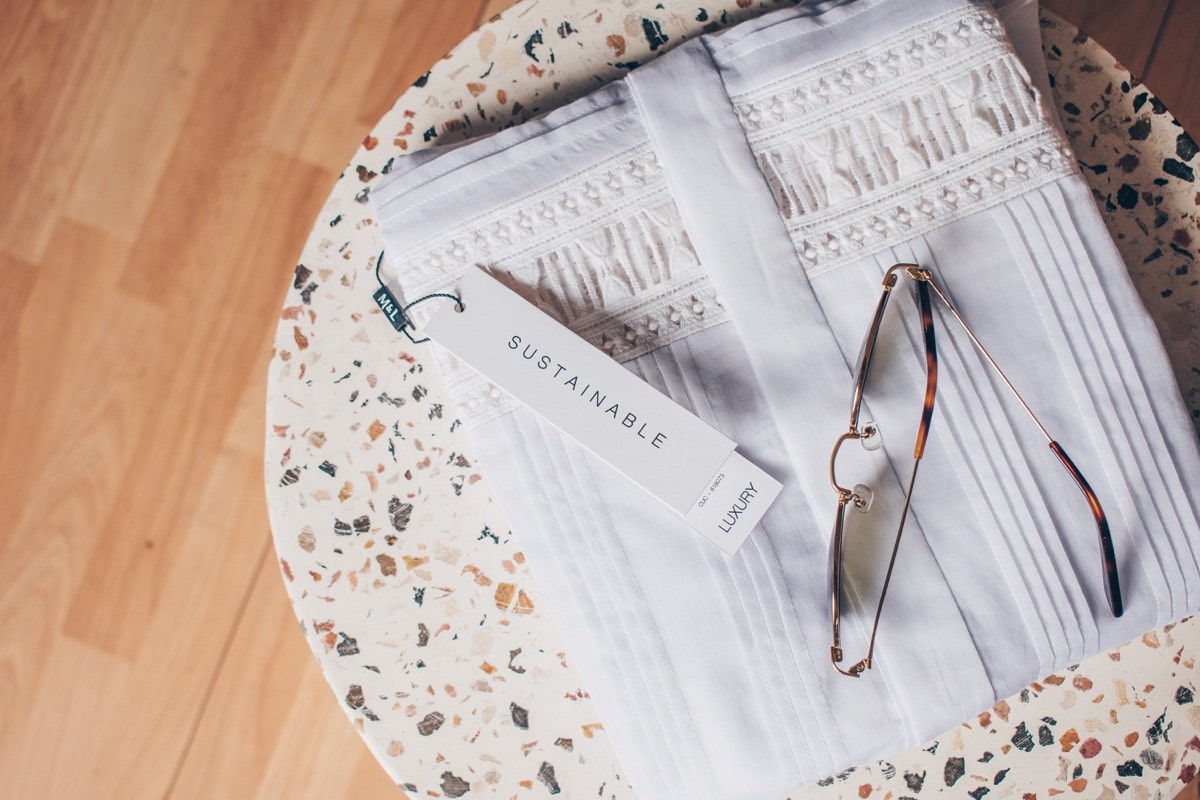Fashion is the opposite of sustainability. Trends come and go every season, asking for a total wardrobe revamp. Most fashionistas are also shopaholics, driving the surge in both clothing sales and resources used for its production. These stereotypes have formed over many decades, but it’s time for them to become relics. New generations are calling for more sustainable fashion choices and fintech can help.

“You spent £7.10 at Tribeca City Cafe. This transaction will produce 3 kg of CO²e,” reads the detailed transaction explanation in the green fintech app Tred. This notification is a simple reminder that everything in the world is interconnected. Every action and every consumption choice, be it a cup of your morning coffee or a new pair of jeans, inevitably impacts the planet’s ecosystem.
Tred is one of the growing number of fintech companies whose aim is to empower responsible consumers on their path to sustainability. Financial apps like that inspire eco-conscious shoppers, visualising the impact and providing tools to remedy ongoing climate changes. However, let’s take off our rose-coloured glasses and clearly see that CO² or other ESG impact tracking is not mainstream at all.
Therefore, this article aims to raise awareness about sustainability when it comes to fashion, as well as fintech solutions that empower consumers to make conscious sustainable shopping choices.
Environmental Impact of the Fashion Industry
According to FashionUnited Business Intelligence, the global fashion industry annually produces at least 100 – 150 billion items of clothing.
The number of apparel items produced each year has doubled since 2000 and exceeded 100 billion for the first time in 2014. One may say, the growth is natural, considering that the global population number increased by about two billion in that period. However, let’s take a closer look at another portion of statistical data.
In 2018, sales from womenswear made up more than half (53%) of global fashion retail spending. Spending on menswear accounted for 31% and, notably, childrenswear for only 16%. Logically thinking, children must be the ones who require the most new clothing and footwear. They are constantly growing, not to mention ruining clothes with their active use. And yet, sales of children’s apparel are statistically the smallest. Numbers just don’t add up.
Moreover, although the average wardrobe contains approximately 148 items, people do not wear at least 50 percent of their closet’s contents. McKinsey & Company estimated that while people bought 60% more garments in 2014 than in 2000, they disposed of the purchased clothes almost 50% quicker.
That naturally leads to a conclusion that a large part of our clothing purchases are driven not by need, but a desire to refresh the wardrobe. Where does it come from? First, there are ever-changing fashion trends. Coupled with the social pressure regarding feminine looks, and so-called ‘fast fashion’ offerings, they pave the way for irresponsible consumerism.
In 2021, people consumed 16.7 units of apparel and footwear spending around $220.70 on average worldwide. These numbers do not reflect the full picture, though, as they don’t take into account millions of people in extreme poverty who can’t even afford food, not to mention new clothes.
Clothing consumption has grown over 400 percent over the past 20 years. Today, global fashion consumers buy over 80 billion new pieces of clothing every year. What is the cost of this surge to the environment?
Geneva Environment Network highlighted that fashion production contributes to 10% of humanity’s carbon emissions – more than all international flights and maritime shipping combined. If the industry continues to grow unchanged, that share of the CO² could surge to 26% by 2050
Besides, it dries up water sources, using 93 billion cubic metres of water – enough to meet the needs of five million people – annually. It is estimated that around 20% of industrial wastewater pollution worldwide originates from the fashion industry.
By the way, around 60% of all materials used in the fashion industry are made from some sort of plastic which is not biodegradable. That is why washing clothes pollutes rivers and streams with microplastic.
Furthermore, 85% of all textiles end up at the dump each year, which is an incredible waste of resources.

What is Sustainable Fashion?
Sustainable fashion aims to achieve net zero clothing production based on the main ESG principles: social equality, eco-friendliness, animal welfare, etc. It is also often called green fashion, eco-fashion, or ethical fashion.
The term is quite wide, encompassing ethical business practices in the fashion industry, using recycled or environmentally friendly materials, and diminishing carbon emissions.
An important part of sustainable fashion is using natural, biodegradable and organic materials, grown and harvested without harmful pesticides and chemicals. Another aspect is that clothing should be durable, good quality and long-lasting, not provoking excessive consumerism.
In addition, the whole production cycle must be responsible, with minimal waste, reduced energy consumption, and use of renewable energy sources. Besides, there should be fair and equal wages along with comfortable working conditions for fashion industry employees.
Moreover, sustainable fashion also often means application of the RRR principles (reduce, reuse, recycle) by consumers. For example, the practices of purchasing vintage clothing, thrifting, mending, repairing, sharing, donating, swapping, and renting clothes are all considered a part of sustainable fashion trends.
How Fintech Can Facilitate Sustainable Fashion
All those goals can be achieved in a seamless way with the help of innovative fintech solutions. There are numerous ways fintech can facilitate the transition to sustainable fashion practices.
- Financial technologies have great data processing and analytical capabilities. Therefore, they can provide both businesses and consumers with actionable insights.
- Many fintech apps are able to calculate carbon impact based on transaction history. Automated data collection and management of greenhouse gas emissions could also leverage blockchain smart contracts to access real-time and trustworthy data and prevent greenwashing.
- Emerging sustainable apparel startups can leverage fintech-enabled loans as their conditions are often more flexible than traditional bank credit.
- E-commerce payment solutions may digitise receipts required to return clothing items, saving tonnes of paper used for physical receipts.
- Blockchain technology can potentially address ESG challenges in the fashion industry, accelerating the monitoring, reporting and verification processes in the supply chain. It can be used to enhance the transparency and traceability of production materials.
- Fintech software and specifically AI tools facilitate ESG reporting of fashion and other businesses. Namely, AI-enabled analytics can fill some of the ESG disclosure gaps and facilitate sustainable investing.
- Fintech-enabled marketplaces may promote sustainable clothing collections, to be used for renting and sharing clothes, as well as re-selling used apparel.
Real World Impact: Use Cases of Fintech Startups Promoting Sustainable Fashion and Responsible Consumption
Tred
At the very beginning of the article, we have already mentioned Tred. This company offers businesses and individuals a recycled plastic debit card and mobile app that help one to understand their carbon footprint and offset the impact with tree planting and other initiatives. The app also provides spending insights and suggestions on how to reduce one’s environmental impact.
Green Story
A similar solution is offered by a SaaS provider Green Story. Its sustainability platform is explicitly dedicated to fashion brands and retailers who want to improve their ESG impact. It shows the environmental performance of fashion products, streamlines the verification process of industry suppliers & supply chain data, and helps consumers see the positive environmental impact of their shopping choices, using Life Cycle Assessment (LCA) methodologies to measure impact and footprint calculations.
Green Story partners with Zalando, Pangaia, Triarchy, thredUP, Rent the Runway, Hanesbrands, and more. In 2022, the clothing brand Weird Fish also introduced environmental impact metrics to its website in partnership with Green Story. The tool shows clients how much has been saved in car emissions, drinking water, lightbulb energy and land pesticide usage as a result of switching from regular to organic cotton.
CoGo
CoGo challenges unsustainable customer behaviours with open banking. The standard enables customers to share their transactional data with third parties. CoGo uses aggregate data to identify which businesses the clients are shopping with and reveal opportunities to shift their spending to businesses that better align with their values.
In 2020, the clothing rental platform HURR integrated CoGo, which enabled customers to see the carbon emission savings when renting instead of purchasing. The tool estimated that a saving of 147kg (367 miles in a car and two trees cut down) is seen each time a £150 dress (£26 rental price) is rented.
Klarna & Good On You
Although BNPL providers like Swedish fintech Klarna are often criticised for enabling fast fashion and irresponsible consumerism, the firm has lately accelerated its sustainability efforts. In 2022, Klarna introduced the first set of Sustainable Collections in its shopping app, in partnership with Good On You, aimed to bring greater transparency to shopping decisions.
Earlier, Klarna launched a carbon emissions tracker. In 2023, the tracker was updated. In addition, Klarna introduced donations for climate-conscious consumers as part of its Buy Now, Pay Later (BNPL) service.
Everledger
This digital transparency platform uses blockchain, NFC and Internet of Things (IoT) to enable apparel and luxury brands to provide secure and transparent records to end consumers and demonstrate its sustainability commitments.
Producers on the Everledger Platform can use the Identify app to provide clear evidence of their production details. In partnership with MCQ, a fashion label from Alexander McQueen, Everledger created MYMCQ, a blockchain-powered tech platform that enables collectors (consumers) to securely register and trade items of clothing designed by a hand-picked selection of collaborators, see the lifecycle of each item, chart its origins to the first purchase, and even resale.
According to the press release, MCQ uses an end-to-end packaging system instead of the current re-packing model. Their collaborators favour recycled, innovative, technical and deadstock fabrics, and aim to increase item lifespan by reselling on the MYMCQ platform. The brand claims to leverage the blockchain platform “in a bid to break the seasonality of fashion, which can push people to consume much more than they need.”










